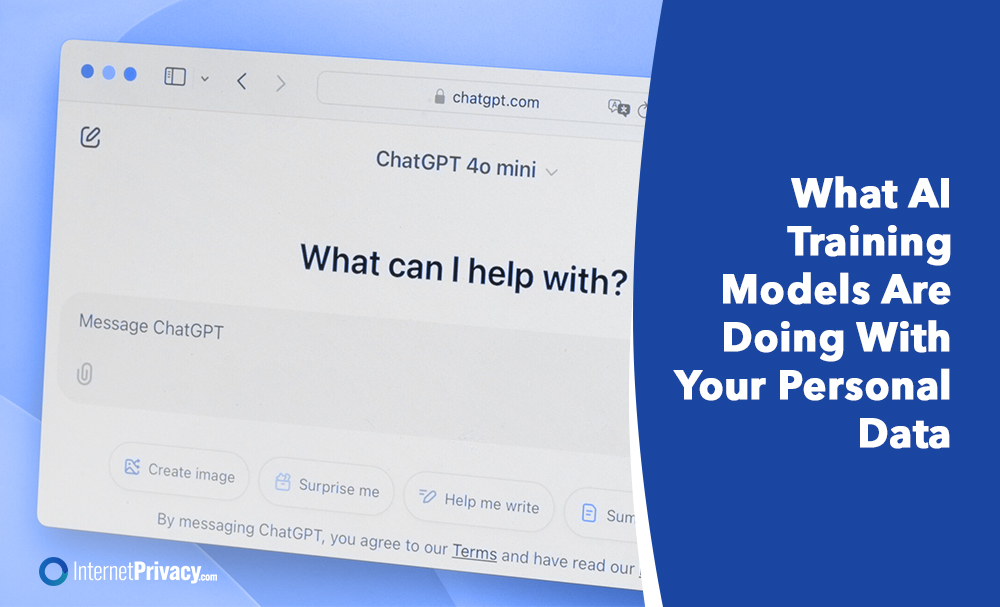What AI Training Models Are Doing With Your Personal Data

Every time you ask a virtual assistant a question, scroll through personalized content, or get a recommendation from a chatbot, you’re engaging with AI training models. These models power the artificial intelligence systems we interact with daily. They simulate human intelligence to automate tasks, solve problems, and generate content.
But here’s the part that’s easy to miss: These AI models don’t just learn from code or anonymous math—they learn from data. Your data. From public posts and online reviews to click patterns and emails, training AI models requires massive amounts of personal information. That has big implications for your privacy.
What Are AI Training Models?
AI training models are systems designed to simulate human intelligence by learning from examples. Just like a human brain learns through repetition, an AI model learns through exposure to labeled and unlabeled data. These models recognize patterns, generate predictions, and perform complex tasks using input data.
Today’s most popular AI models rely on deep learning techniques powered by artificial neural networks. These algorithms mimic how neurons in the human brain fire. Developers train them using vast datasets, often pulled from websites, social platforms, and other online spaces where people share information. Many people don’t realize that this data might be used for AI research.
Types of AI Training Models
AI models don’t all learn the same way. Their training depends on the task and the available data. Below are four common approaches:
Supervised Learning:
Developers train models using input data paired with known outputs (ground truth data). This method is often used in classification and regression models.
Example: A spam filter learns from thousands of emails labeled “spam” or “not spam.”
Unsupervised Learning:
A method that works when data lacks labels. The model groups similar data points based on structure or behavior.
Example: Identifying customer behavior patterns in e-commerce.
Reinforcement Learning:
The model learns by receiving rewards or penalties for its decisions. It’s often used in dynamic environments.
Example: Teaching robots to walk or AI agents to play games.
Semi-Supervised Learning:
Here, small amounts of labeled data mix with large sets of unlabeled data, reducing the need for extensive human intervention.
While these approaches help build better models, more data can mean greater privacy risks.
What Data Do AI Models Use—and Why It Matters
Developers need a lot of training data to build artificial intelligence models that can handle language, images, and predictions. AI systems collect data from several sources, including:
- Web scraping: Public forums, social media, blogs, and websites
- User interactions: Emails, messages, click history, and app activity
- Surveys and third-party brokers: Personal details sold or shared between companies
Large language models often rely on data from the public-facing internet. This includes Reddit posts, tweets, Wikipedia edits, product reviews, and more.
Sometimes, developers anonymize this data. Other times, they don’t. Several companies have faced legal complaints about using copyrighted content or identifiable personal data. If content is online and not protected, it might end up in training datasets.
How Does AI Model Training Work?
Once developers gather the data, the training process includes several steps:
1. Data Collection and Preparation
Data scientists collect, clean, and format the training data. They remove duplicates and correct inconsistencies. Then, they decide which data points are helpful for building models. Ideally, any sensitive data should be stripped or protected. Unfortunately, that doesn’t always happen.
2. Model Training
The system feeds the data into deep neural networks. These networks include multiple layers that help the model recognize patterns. Depending on the task, the process may use:
- Classification models (e.g., spam detection or facial recognition)
- Regression models (e.g., pricing forecasts or demand prediction)
- Support vector machines (e.g., used in bioinformatics and handwriting recognition)
More data generally helps the AI model make more accurate predictions.
3. Validation and Testing
After training, developers test the model using new data. This step checks whether the AI system performs well or memorizes the training data.
4. Model Deployment and Use
Once tested, the AI model goes into production. It powers voice assistants, drives recommendation engines, or analyzes financial transactions. Running AI models requires sufficient computing power, including CPUs and GPUs.
However, here’s the catch: If the model was trained on personal data without consent, it might still retain or reproduce that information, even after deployment.
Why This Raises Privacy Concerns
AI systems rely on large-scale data acquisition. However, the line between public and personal data is often blurred.
- Was your old blog post used to train a chatbot?
- Did a photo you shared online help improve object detection models?
- Is something you wrote now part of a model’s understanding of how people think?
These aren’t just theoretical questions. In some cases, AI models have reproduced sensitive details—like names, locations, and even medical records—that were part of the original training data.
Without stricter rules, companies can use your data to train AI models without asking. Regulations like the GDPR and California Consumer Privacy Act try to protect you. However, enforcement often lags behind the rapid pace of AI development.
Benefits of AI Training Models (and Why They Still Matter)
Despite privacy concerns, AI training offers significant advantages:
- Faster and more accurate predictions in healthcare, logistics, and science
- Automation of complex tasks such as language translation, fraud detection, or image recognition
- Personalized experiences in shopping, entertainment, and customer support
So, the debate isn’t about whether we use AI—it’s about how we use it responsibly.
How to Protect Your Personal Data
You can’t stop every data scrape. But you can take control of what you share. Try these tips:
- Review privacy settings on apps, websites, and social media platforms
- Limit personal information in public spaces online
- Use privacy tools like VPNs, encrypted browsers, and ad blockers
- Read privacy policies to understand how your data may be used for training
- Opt out where you can: Some platforms let you exclude your data from model training
Final Thoughts
Training AI models depends on data; that data increasingly comes from you. From online conversations to browsing habits, personal information shapes how artificial intelligence systems evolve.
These systems aren’t magical. Millions of data points power them—gathered, sorted, and fed into machine learning pipelines. Unless developers prioritize transparency and consent, your privacy might be the cost of progress.
So, understanding how AI training models work isn’t just for tech experts. It’s about protecting your rights in a world increasingly run by machines.





